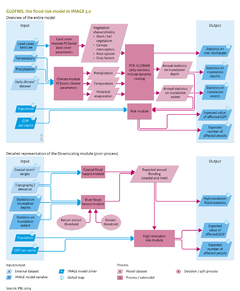Flood risks/Data uncertainties limitations: Difference between revisions
Jump to navigation
Jump to search
No edit summary |
No edit summary |
||
| Line 10: | Line 10: | ||
* The effect of levee breaches also has not been included. This can have large impacts on flood patterns. For example, during the Pakistan floods of 2009, a large part of a major embankment was destroyed by the floods, causing a completely different flood pattern than would be simulated by any model under the assumption of levee overtopping as the only flood mechanism. If the user is interested in this type of flood mechanisms, a more interactive approach to mapping flood hazard is required, which would allow for ‘what if’ scenarios on the schematisation of the elevation profile within a case study area. Obviously, such ‘what if’ scenarios are not suited for a global approach, such as presented here. | * The effect of levee breaches also has not been included. This can have large impacts on flood patterns. For example, during the Pakistan floods of 2009, a large part of a major embankment was destroyed by the floods, causing a completely different flood pattern than would be simulated by any model under the assumption of levee overtopping as the only flood mechanism. If the user is interested in this type of flood mechanisms, a more interactive approach to mapping flood hazard is required, which would allow for ‘what if’ scenarios on the schematisation of the elevation profile within a case study area. Obviously, such ‘what if’ scenarios are not suited for a global approach, such as presented here. | ||
* Relatively simple stage-damage functions are used to estimate risks related to flood hazard and exposure. These functions vary greatly across the globe and may even represent the largest absolute uncertainty in our model results. | * Relatively simple stage-damage functions are used to estimate risks related to flood hazard and exposure. These functions vary greatly across the globe and may even represent the largest absolute uncertainty in our model results. | ||
* Flood risk is modelled as a function of flood hazard, exposure, and vulnerability, with vulnerability being assumed to remain the same over time and space. However, future developments in resilience and adaptation measures may reduce vulnerability (e.g. due to increased awareness, other building methods or flood warning procedures). | * Flood risk is modelled as a function of flood hazard, exposure, and vulnerability, with vulnerability being assumed to remain the same over time and space. However, future developments in resilience and adaptation measures may reduce vulnerability (e.g. due to increased awareness, other building methods or flood warning procedures). <br/> | ||
}} | }} | ||
Revision as of 11:58, 17 December 2013
Parts of Flood risks/Data uncertainties limitations
| Component is implemented in: |
|
| Related IMAGE components |
| Models/Databases |
| Key publications |
